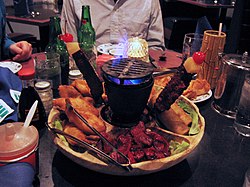Pu pu platter
 Pu pu platter
Pu pu platterA pu pu platter, pu-pu platter or pupu platter is a tray of American Chinese or Hawaiian food, consisting of an assortment of small meat and seafood appetizers. A typical pupu platter, as found in American Chinese cuisine, might include an egg roll, spare ribs, chicken wings, chicken fingers, beef teriyaki, skewered beef, fried wontons, crab rangoon, fried shrimp, among other items, accompanied by a small hibachi grill.
The pupu platter was probably first introduced to restaurants on the United States mainland by Don the Beachcomber in 1934. It has since became a standard at most Polynesian themed restaurants such as Don's and Trader Vic's. The earliest known print reference to a pupu platter served at a Chinese restaurant is from 1969.
Later, other types of restaurants used pu pu platter to mean an appetizer combination platter. However, pu pu platters are currently more closely associated with American Chinese restaurants.
In the Hawaiian language, pū-pū denotes a relish, appetizer, canapé, or hors d'oeuvre; it originally meant "shell fish', but also referred to small bits of fish, chicken, or banana relish served with kava and beans.
Since the introduction of commercial dining and drinking establishments in Hawaii, pūpū were, and remain, standard fare in island establishments. An establishment that serves "heavy pupus" will often have a buffet table with warming trays full of chicken, tempura vegetables, shrimp, poke (cubed and seasoned raw fish), small skewers of teriyaki meat or chicken, sushi, and other similar finger foods. An establishment that serves "light pupus" usually will offer only the cold foods such as poke, sushi, and vegetables. Some establishments will serve pūpū to the table.
...
Wikipedia